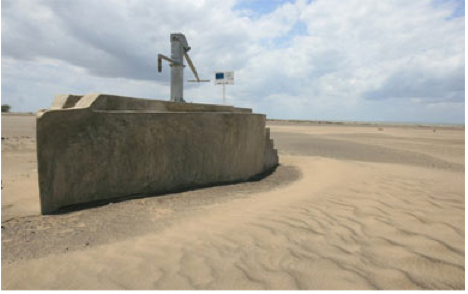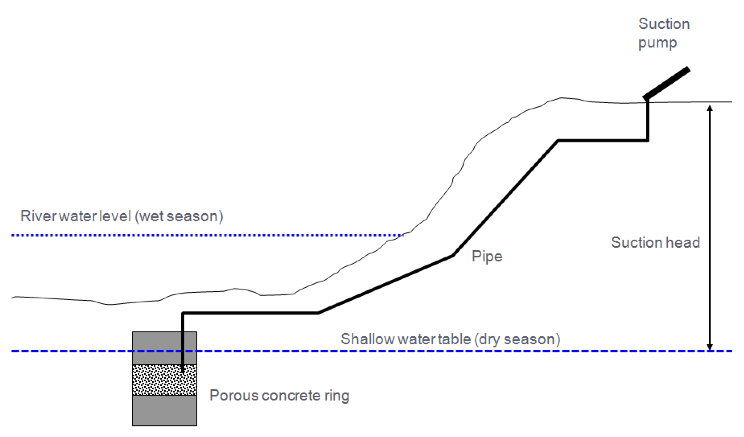Riverbed hand-dug wells
| |
|
|
|
|
|
|
|
|
|
These are shallow wells which draw water from a natural or man-made aquifer specifically within a riverbed. The simplest version of these is a shallow hole dug every season in a riverbed which gets flooded with every flood event. Other versions allow the water to be accessed all year round through Handpumps or Small and efficient motor pumps. A bucket and rope can be used but risk of contamination increases. In such a case, household water treatment should be advocated.
Contents
[hide]Suitable conditions
- Wells need to be sited in riverbeds that are dry for part of the year, allowing construction to take place.
- There should be water remaining in the riverbed throughout the dry season.
- Where wells are dug with the intention to abstract water using manual or motorized suction pumps, due to pumping requirements it is best to site these wells:
- Within 30 metres of the pump location.
- In areas where there are no high banks and where maximum floodwater height is lower than these banks – this is so that suction pumps can still operate (effectively will abstract water between 6 – 7 metres height).
| Advantages | Disadvantages |
|---|---|
| - Taps water in riverbed rather than through riverbanks (if very defined aquifer where water is confined to riverbed) - Lower cost than making a lined well in the riverbank due to less lining needed |
- Contamination possibility of water due to limited filtration depth between surface water to intake. - Can be difficult to sink to required depth especially in areas of flowing sand. |
Resilience to changes in the environment
Drought
Effects of drought: Can dry up.
Underlying causes of effects: Less recharge of aquifer due to less rainfall; Increasing population & water demand; Size of aquifers – e.g. limited sand volume; Wells not sunk deep enough into water table; Incorrect siting; Graded gravel around pipe not correctly done.
To increase resiliency of WASH system: Increase volume through construction of groundwater dam; Sink wells/pipes deeper; De-water wells during caissoning within the water table; Construct during the latter half of the dry season; Site in riverbeds that are dry for part of the year, where water remains in the riverbed throughout the dry season; Increase flow by use of porous concrete & perforated pointed steel pipes driven horizontally into the aquifer (riverbed wells) and graded gravel (infiltration galleries & jetted wells); Site in a degrading river section where there is no deposition (infiltration galleries); Put graded gravel around pipes to minimize clogging and increase flow.
More information on managing drought: Resilient WASH systems in drought-prone areas.
Construction, operations and maintenance

General advice on cement: A common cause of cracks in structures and linings (e.g. in tanks, dams, waterways, wells) is errors in mixing and applying the cement. First of all, it is important that only pure ingredients are used: clean water, clean sand, clean rocks. The materials have to be mixed very thoroughly. Secondly, the amount of water during mixing needs to minimal: the concrete or cement needs to be just workable, on the dry side even, and not fluid. Thirdly, it is essential that during curing the cement or concrete is kept moist at all times, for at least a week. Structures should be covered with plastic, large leaves or other materials during the curing period, and kept wet regularly.
Specific advice: Simplify construction methods while getting a more robust end product in a safer fashion. Pre-cast concrete rings can be used, but is more easily done with a cutting foundation ring and curved concrete blocks, some of which are made from porous concrete.
Ensure that wells are dug deep enough to allow enough flow during the dry season.
For sand rivers that have a significant clay content, permeability will be low, and yields will also be low. Increased flow velocity into the well can be created by making a large gravel pack around the well shaft – this gravel pack consists of aggregate and stones (rather than the traditional type of small diameter gravel pack used in boreholes).
For where the well is made within or partially within a riverbed where it will be flooded or have floodwater beside or close to it:
- The well shaft can be made so that it is buried within the sand, and is uncovered after each flood event for access to the water. A slab is made to cover the top ring and a manhole access cover is created for dry season access but which can be closed during a flood event. In such a case:
- The top of the ring should be ideally 1.5 metres minimum from the riverbed surface. This is so that:
- There is at least a minimum of infiltration that occurs from surface water during the wet season when the river is flooded
- That there is less chance that the well shaft and pipework will be washed away in a flood event. Sand becomes mobile to a certain depth which differs for different rivers but has been recorded to be normally between 0.66 and 2 metres in seasonal riverbeds.
- The well shaft can also be made so that it protrudes from the riverbed sand level. A slab is made to cover the top ring and a manhole access cover is installed for dry season access. In such a case:
- The well shaft needs to be protected – a hydrodynamic well head should be constructed to minimize damage from floodwater and the debris it contains. This well head has a shape of an upturned boat which deflects water and debris in the floodwater. The manhole cover opens in the upstream direction so that it closes when the floods arrive.
- Such a construction is probably best suited to riverbeds of low porosity and permeability where sediments have some stability and little is transported in floodwater, otherwise damage to the well could easily take place.
The use of porous concrete in part of the section of the well shaft which is underwater can help increase flow velocity into the well. Porous concrete is made using a of 1 : 1 : 4 (cement : sand : aggregate) and can be used for curved blocks or also for a central portion of any pre-cast concrete ring. Also perforated pointed steel pipes can be driven horizontally into the aquifer using a jack – this can also increase flow velocity into the well.
Manuals, videos and links
- Well revival effort sees many other benefits A community drive to revive wells in Mokhla talab near Udaipur results in water security for longer periods of time as well as making leaders out of women.
- Experiments with 'community wells' Mobilized farmers in Dhule, Maharashtra, show how communities can use groundwater as a common resource in an organised and collective manner.
- Water from dry riverbeds. Advises how to survey a river and much more. Danish International Development Assistance (Danida). 2006.
- Hand-dug well equipment. Covering well auger survey, well digging, dewatering and desludging kits. Oxfam Water Supply Scheme for Emergencies.
Acknowledgements
- CARE Nederland, Desk Study: Resilient WASH systems in drought-prone areas October 2010.



